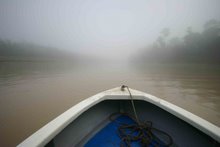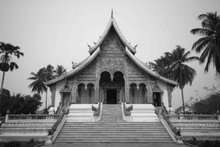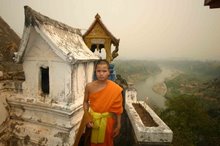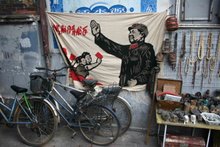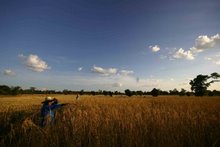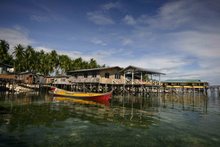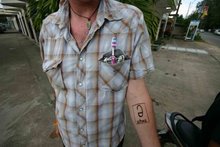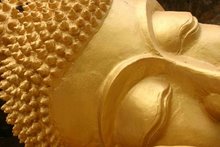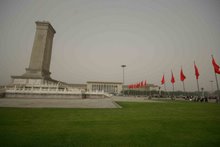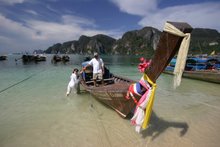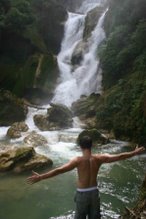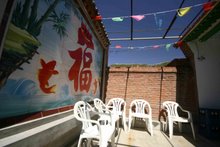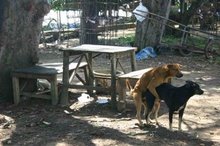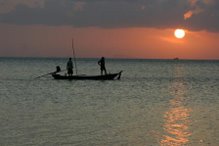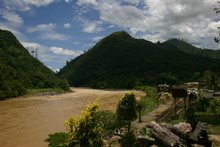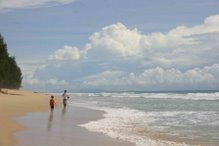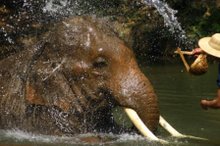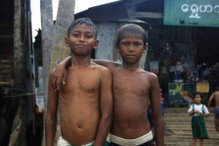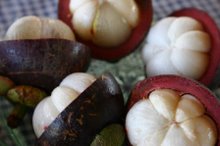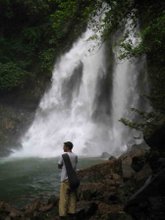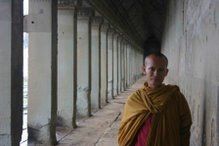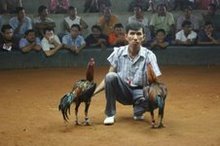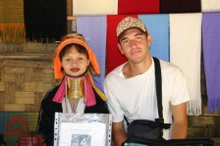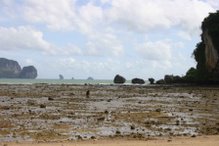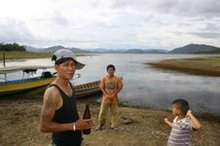
 There’s no direct translation for the dish. I don’t know what to call it on a menu, but the longer description would be spicy, sweet, and sour thin glass noodles mixed with pork. At my students Ing and Iw's house, they decided to teach me to cook this dish admitting from the beginning that it might be delicious, and it might not. The did however guarantee that it would be edible.
There’s no direct translation for the dish. I don’t know what to call it on a menu, but the longer description would be spicy, sweet, and sour thin glass noodles mixed with pork. At my students Ing and Iw's house, they decided to teach me to cook this dish admitting from the beginning that it might be delicious, and it might not. The did however guarantee that it would be edible.
First we chopped up the pork. Well, kind of. We just mutilated it with a knife, somewhere between mincing it and pulverizing it. By the time we were done with it, it didn't really look like anything.
 Then we boiled water and softened the glass noodles in it. Seconds later we took out the noodles and put them in a bowl before dropping in our pork. The gelatinous pork cooked quickly and was then added to the noodles.
Then we boiled water and softened the glass noodles in it. Seconds later we took out the noodles and put them in a bowl before dropping in our pork. The gelatinous pork cooked quickly and was then added to the noodles.
 Mixed with the noodles and pork was: peanuts, fish sauce, lime juice, thinly sliced cucumber, more fish sauce, 7 chilies (an amount we decided perfect after a small debate and each eating one raw), garlic, sugar, more fish sauce, chili sauce, tiny tomatoes, more chili sauce, and MSG (pictured). And then we took a taste only to find out it needed more fish sauce.
Mixed with the noodles and pork was: peanuts, fish sauce, lime juice, thinly sliced cucumber, more fish sauce, 7 chilies (an amount we decided perfect after a small debate and each eating one raw), garlic, sugar, more fish sauce, chili sauce, tiny tomatoes, more chili sauce, and MSG (pictured). And then we took a taste only to find out it needed more fish sauce.
 It’s a strange mix to stir. The noodles stick together, the meat and noodles stick together and the rest just looks funny and spreads around unevenly. After stirring long enough, it finally mixed well enough and the result was a classic Thai dish; an intersection of just about every flavor and texture our palates can sense. Spicy, sweet, sour, crunchy, soft, chewy.
It’s a strange mix to stir. The noodles stick together, the meat and noodles stick together and the rest just looks funny and spreads around unevenly. After stirring long enough, it finally mixed well enough and the result was a classic Thai dish; an intersection of just about every flavor and texture our palates can sense. Spicy, sweet, sour, crunchy, soft, chewy.
I will say that this dish is not photogenic. If you went to a Thai restaurant and saw a picture of it on the wall, you’d go for something else. It’s actually quite delicious. Maybe my palate has adjusted after living here for over a year and a half but I really liked it. It wasn't the only thing we ate either. Along with the dish we had sticky rice, an omelet, garlic-dried pork and red fanta. Sap!

After dinner we took a walk through their village. Admittedly, I didn’t expect to see much but I guess this is why I take these chances and try to say yes to every opportunity that arises. A small walk down a dirt road turned into a bio-culture class taught by Ing and Iw.

Whether they know it or not, the girls are extremely aware of their natural surroundings. As we walked down the street they pointed out different flowers, naming them in Thai and an English. One hanging bright yellow flower was a culture symbol of Thailand, another was used for the traditional flowers they decorate Buddha images with. As I looked out into the woods and saw dry, crackling brush growing amongst boring trees, Ing and Iw saw food. They showed me the tiny fruits of different trees and easily identified other fruit trees that had been picked clean. It soon realized that just about every single tree in the village produced an edible fruit of some sort.
 Jackfruit, limes, tamarinds, papayas, pineapples, coconuts, bananas, and a myriad of fruits I’ve never heard of grew everywhere. The girls even pointed out root vegetables that looked like weeds and trees used for making paper, all on a 2 kilometer walk.
Jackfruit, limes, tamarinds, papayas, pineapples, coconuts, bananas, and a myriad of fruits I’ve never heard of grew everywhere. The girls even pointed out root vegetables that looked like weeds and trees used for making paper, all on a 2 kilometer walk.
Half way through I laughed thinking that if I had been stuck here all alone, I’d have starved unaware of how most fruits and vegetables grow and clueless as to what other things are edible. The girls on the other hand looked around the woods as we Americans would look through our pantry.
 While walking by houses I was stared at. A lot. Ing and Iw told me I was the first white person they’re grandfather had ever seen. He’s 90. I was afraid I was going to give the old guy a heart attack. I'm sure this small street and village is not a place falang usually end up. As we walked through the village people looked out and quickly asked the girls what the hell I was doing there. I avoided most conversation, pretending to not understand, just smiling instead. This made the walk go a little faster and allowed the girls to decide when and where we should stop and chat.
While walking by houses I was stared at. A lot. Ing and Iw told me I was the first white person they’re grandfather had ever seen. He’s 90. I was afraid I was going to give the old guy a heart attack. I'm sure this small street and village is not a place falang usually end up. As we walked through the village people looked out and quickly asked the girls what the hell I was doing there. I avoided most conversation, pretending to not understand, just smiling instead. This made the walk go a little faster and allowed the girls to decide when and where we should stop and chat.
 A walk through time, old women worked in front of their family home weaving large rugs and blankets on complex looms of bamboo, wood and string. This lady said she had already been working on this particular piece for a month. Beyond the actual weaving, the slow process of spinning the homemade yarn into spools and preparing the loom is a task I can hardly imagine. Sure, these ladies have nothing but time but it's still hard to imagine having that much patience to spend a couple months making it and then sell the rug for $20.
A walk through time, old women worked in front of their family home weaving large rugs and blankets on complex looms of bamboo, wood and string. This lady said she had already been working on this particular piece for a month. Beyond the actual weaving, the slow process of spinning the homemade yarn into spools and preparing the loom is a task I can hardly imagine. Sure, these ladies have nothing but time but it's still hard to imagine having that much patience to spend a couple months making it and then sell the rug for $20.
 As the sun burst through a cluster of small clouds, we continued walking to a local pond where we saw several people leading their cows and water buffaloes back home. Ing and Iw found river snails and clams in the river, both of which they claim are delicious, adding to their long list of edibles that I would have looked over. (I'd kill a cow.) Heading back in a different direction we walked to a wat where monks had built a small waterfall, and strode past a school yard busy with volleyball, takra, and potato sack races. By the time we were back at their place I was completely exhausted, ready to head home, my brain full of new Thai fruits and my belly full of new Thai food.
As the sun burst through a cluster of small clouds, we continued walking to a local pond where we saw several people leading their cows and water buffaloes back home. Ing and Iw found river snails and clams in the river, both of which they claim are delicious, adding to their long list of edibles that I would have looked over. (I'd kill a cow.) Heading back in a different direction we walked to a wat where monks had built a small waterfall, and strode past a school yard busy with volleyball, takra, and potato sack races. By the time we were back at their place I was completely exhausted, ready to head home, my brain full of new Thai fruits and my belly full of new Thai food.






















































